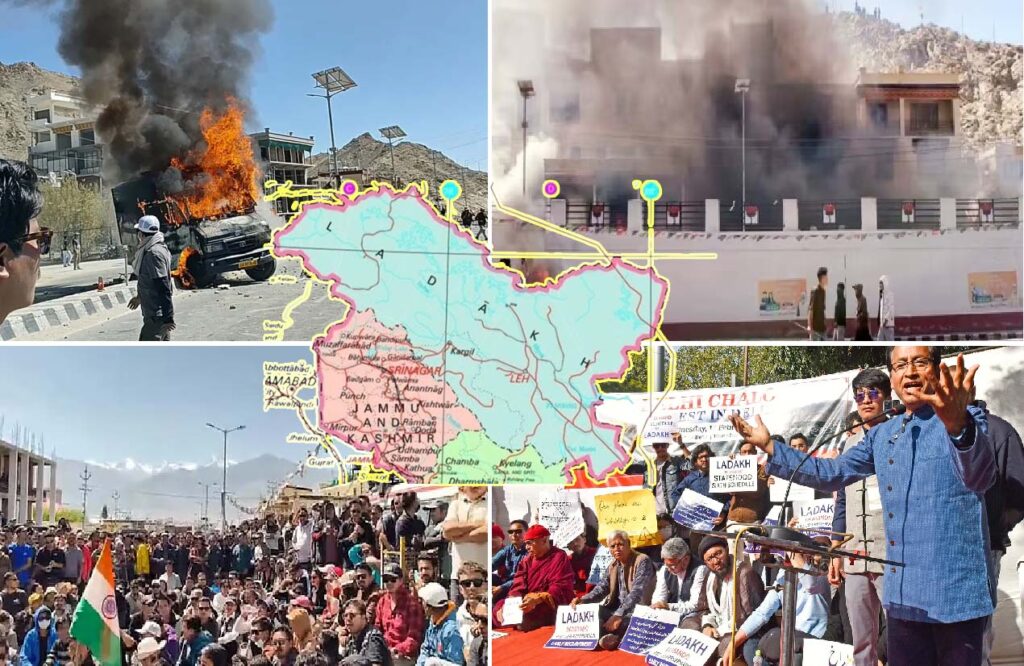
- Granting full statehood to Ladakh at present would carry strategic, governance, and social risks that outweigh the political gains and could weaken India’s capacity to manage a complex and dangerous neighbourhood.
- Any administrative change in Ladakh that reduces central oversight risks giving adversaries openings to exploit governance gaps, build local proxies or press territorial claims, especially in remote stretches where clear, unified central policy is vital.
- Ladakh already has institutional mechanisms for local governance, LAHDCs, which are designed to deliver local development, culture-protecting measures and community-level decision-making while key strategic functions remain with the Union government.
- Ladakh’s future must not be shaped by engineered protests or political symbolism, but by a pragmatic assessment that its governance is inseparable from India’s national security.
Ladakh has been besieged by protests engineered over granting statehood and bringing the region under the Sixth Schedule. Ladakh is not an interior state; it is a frontline border region sharing contested borders and corridors of strategic importance to both India and China. Statehood is not a neutral administrative upgrade in a region that sits on one of India’s most sensitive frontiers. Granting full statehood to Ladakh at present would carry strategic, governance, and social risks that outweigh the political gains and could weaken India’s capacity to manage a complex and dangerous neighbourhood.
Since the 2019 reorganisation of Jammu & Kashmir, which created Ladakh as a union territory under central administration, New Delhi has centralised control precisely because of these security realities and the need for fast, coordinated decisions on defence, infrastructure and communications. The region’s infrastructure projects, force deployments and diplomacy with neighbours must be managed with national-level coherence; splitting decision-making by creating a state could complicate rapid central responses in future crises.
The Protest Dynamics & Government’s Response
Demonstrations called by high-profile activist Sonam Wangchuk turned violent, leading to damage to public and private infrastructure and causing injuries to many, including security personnel. The organisers of these protests, including Wangchuk, have been accused by the administration of inciting statements and suspected ties to networks that amplified the protests.
In response to the protests, the Ministry of Home Affairs issued a detailed press release on September 24, 2025, outlining both its ongoing engagement and its account of the violent turn of events. It noted that the Centre has been holding structured dialogues with Apex Body Leh and the Kargil Democratic Alliance through a High-Powered Committee, which has already delivered outcomes such as raising ST reservations from 45% to 84%, introducing one-third women’s reservation in councils, declaring Bhoti and Purgi as official languages, and initiating recruitment for 1,800 posts. The government accused politically motivated individuals of attempting to sabotage this process and stated that provocative speeches during the hunger strike incited the mob violence on September 24 that left over 30 security personnel injured. Reaffirming its commitment to Ladakh’s aspirations through constitutional safeguards and continued dialogue, it cautioned against misinformation and emphasised that talks with local leaders are ongoing.
The China–Gilgit–Baltistan Factor
To understand why statehood is not a local matter, one must see Ladakh in the context of the broader north-western frontier. Across the LAC in Ladakh is the Pakistan-occupied Indian territory of Gilgit-Baltistan, where Chinese economic and military footprints have expanded through CPEC-related projects. Any administrative change in Ladakh that reduces central oversight risks giving adversaries openings to exploit governance gaps, build local proxies or press territorial claims, especially in remote stretches where clear, unified central policy is vital. Recent literature and analyses underline how infrastructure and territorial control in these borderlands are part of broader geostrategic competition with China.
Existing Hill Councils with Central Oversight is The Safer Path
Ladakh already has institutional mechanisms for local governance. The Ladakh Autonomous Hill Development Councils (LAHDCs) for Leh and Kargil were designed to deliver local development, culture-protecting measures and community-level decision-making while key strategic functions remain with the Union government. Strengthening these councils by ensuring resources, faster implementation of local recruitment, and greater administrative clarity addresses many grievances without sacrificing national security prerogatives.
Demands that Ladakh be brought under the Sixth Schedule (which provides special safeguards and tribal autonomy in northeast India) are a call to safeguard culture as well as land rights. But the Sixth Schedule model was developed for other historical and demographic situations; inserting Ladakh in that category without careful adaptation might generate jurisdictional confusion, hinder united national planning, and generate overlap of governance, particularly where defence, allotment of land for security infrastructure, and environmental management overlap. A hasty constitutional transplant may generate legal conflict and administrative stasis at a moment when unclouded lines of command are important.
Protest-to-Policy Precedent
Granting statehood through pressure sets a precedent: mass, disruptive demonstrations, even if it is based on justifiable grievances, will become a means of constitutional reform. That process can be hijacked by well-organised political players (ideological and partisan forces) in order to advance narrow agendas or by foreign forces who want to promote instability in volatile areas. There are reasonable concerns that some agitation carries the imprint of political propaganda or that well-funded campaigns amplify unrest in ways that do not reflect the majority’s long-term interest.
However, blanket accusations of conspiracy are unhelpful; the answer is rigorous, transparent inquiry and a clear pathway for legitimate demands to be addressed through law, not street pressure. Recent actions, such as scrutiny of funding sources for organisations involved in agitation, have been framed by authorities as necessary to prevent external interference. Such measures should be balanced, lawful, and transparent. Ultimately, a consultative, legally secure, phased approach that balances local empowerment with protection of national interest is far preferable.
A Safer, Phased Alternative
Ladakh’s geography, vast high-altitude deserts, thinly populated plateaus and fragile ecosystems mean that the usual metrics used for statehood (population, revenue, administrative viability) function differently. Making Ladakh a full state in the classical sense would turn a sparsely populated frontier into a politically autonomous unit whose decisions might not always align with national strategic needs. In short, geography here is security; administrative fragmentation can be exploited by adversaries in asymmetric ways. Ladakh deserves to safeguard its culture, generate jobs and gain a stronger voice in governance. Hence, the LAHDCs must be reinforced and reformed urgently through an expansion of their financial powers, fast-tracking local recruitment quotas, and institutionalising quicker project clearances.
Concurrently, an upper-level, time-bound and open-ended discussion must be initiated, engaging Ladakhi civil society, LAHDC members, retired security professionals, and constitutional jurists to develop a phased autonomy strategy. Security-sensitive decision-making also has to be safeguarded by holding defence, foreign affairs, border infrastructure, and emergency powers of the central government, entrusting non-strategic governance to local councils. Cultural and land protection issues should be treated through statutorily assured custom-made solutions, specifically for Ladakh, as opposed to the imposition of wholesale constitutional packages that may be irrelevant to the specific context of Ladakh.
Ultimately, Ladakh’s future must not be shaped by orchestrated protests or political symbolism, but by a pragmatic assessment that its governance is inseparable from India’s national security.
Tejashree P V holds a Master’s degree in English Literature from IGNOU and a Bachelor’s degree in Journalism, English, and History from Vivekananda Degree College. A UPSC aspirant, she has a keen interest in international affairs, geopolitics, and policy.
